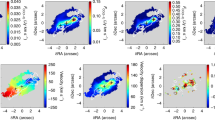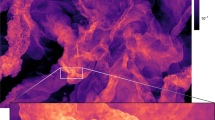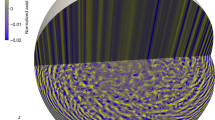Abstract
A fundamental property of molecular clouds is that they are turbulent1, but how this turbulence is generated and maintained is unknown. One possibility is that stars forming within the cloud regenerate turbulence via their outflows, winds and radiation (‘feedback’)2. However, disentangling motions created by feedback from the initial cloud turbulence is challenging. Here, we confront the relationship between stellar feedback and turbulence by identifying and separating the local and global impact of stellar winds. We analyse magnetohydrodynamic simulations in which we track wind material as it interacts with the ambient cloud. By distinguishing between launched material, gas entrained by the wind and pristine gas we show energy is transferred away from the sources via magnetic waves excited by the expanding wind shells. This action at a distance enhances the fraction of stirring motion compared with compressing motion and produces a flatter velocity power spectrum. We conclude that stellar feedback accounts for significant energy transfer within molecular clouds—an impact enhanced by magnetic waves, which have previously been neglected by observations. Overall, stellar feedback can partially offset global turbulence dissipation.
This is a preview of subscription content, access via your institution
Access options
Access Nature and 54 other Nature Portfolio journals
Get Nature+, our best-value online-access subscription
$29.99 / 30 days
cancel any time
Subscribe to this journal
Receive 12 digital issues and online access to articles
$119.00 per year
only $9.92 per issue
Buy this article
- Purchase on Springer Link
- Instant access to full article PDF
Prices may be subject to local taxes which are calculated during checkout




Similar content being viewed by others
Data availability
The data that support the plots within this paper and other findings of this study are available from the corresponding author upon reasonable request.
References
McKee, C. F. & Ostriker, E. Theory of star formation. Ann. Rev. Astron. Astrophys. 45, 565–687 (2007).
Krumholz, M. R. et al. in Protostars and Planets VI (eds Beuther, H., Klessen, R. S., Dullemond, C. P. & Henning, T.) 243–266 (University of Arizona Press, Tucson, AZ, 2014).
Offner, S. S. R. et al. in Protostars and Planets VI (eds Beuther, H., Klessen, R. S., Dullemond, C. P. & Henning, T.) 53–75 (University of Arizona Press, Tucson, AZ, 2014).
Stone, J. M., Ostriker, E. C. & Gammie, C. F. Dissipation in compressible magnetohydrodynamic turbulence. Astrophys. J. Lett. 508, L99–L102 (1998).
Elmegreen, B. G. Star formation in a crossing time. Astrophys. J. 530, 277–281 (2000).
Vázquez-Semadeni, E. et al. Molecular cloud evolution. II. From cloud formation to the early stages of star formation in decaying conditions. Astrophys. J. 657, 870–883 (2007).
Robertson, B. & Goldreich, P. Adiabatic heating of contracting turbulent fluids. Astrophys. J. Lett. 750, L31–L36 (2012).
Heitsch, F. & Hartmann, L. Rapid molecular cloud and star formation: mechanisms and movies. Astrophys. J. 689, 290–301 (2008).
Hopkins, P. F. et al. Galaxies on FIRE (feedback in realistic environments): stellar feedback explains cosmologically inefficient star formation. Mon. Not. R. Astron. Soc. 445, 581–603 (2014).
Agertz, O. & Kravtsov, A. V. On the interplay between star formation and feedback in galaxy formation simulations. Astrophys. J. 804, 18–38 (2015).
Gatto, A. et al. The SILCC project—III. Regulation of star formation and outflows by stellar winds and supernovae. Mon. Not. R. Astron. Soc. 466, 1903–1924 (2017).
Caldú-Primo, A. et al. A high-dispersion molecular gas component in nearby galaxies. Astron. J. 146, 150–164 (2013).
Krumholz, M. R. & Burkhart, B. Is turbulence in the interstellar medium driven by feedback or gravity? An observational test. Mon. Not. R. Astron. Soc. 458, 1671–1677 (2016).
Offner, S. S. R. & Arce, H. G. Impact of winds from intermediate-mass stars on molecular cloud structure and turbulence. Astrophys. J. 811, 146–165 (2015).
Matzner, C. D. On the role of massive stars in the support and destruction of giant molecular clouds. Astrophys. J. 566, 302–314 (2002).
Heitsch, F. & Burkert, A. Alfvén-wave driven turbulence in molecular clouds. In Modes of Star Formation and the Origin of Field Populations (eds Grebel, E. K. & Brandner, W.) 13–29 (Conference Series Volume 285, Astronomical Society of the Pacific, San Francisco, CA, 2002).
Wang, P., Li, Z., Abel, T. & Nakamura, F. Outflow feedback regulated massive star formation in parsec-scale cluster-forming clumps. Astrophys. J. 709, 27–41 (2010).
Offner, S. S. R. & Chaban, J. Impact of protostellar outflows on turbulence and star formation efficiency in magnetized dense cores. Astrophys. J. 847, 104–123 (2017).
Tritsis, A. & Tassis, K. Magnetic seismology of interstellar gas clouds: unveiling a hidden dimension. Science 360, 635–638 (2018).
Larson, R. L., Evans, N. J. II, Green, J. D. & Yang, Y.-L. Evidence for decay of turbulence by MHD shocks in the ISM via CO emission. Astrophys. J. 806, 70–75 (2015).
Carroll, J. J., Frank, A., Blackman, E. G., Cunningham, A. J. & Quillen, A. C. Outflow-driven turbulence in molecular clouds. Astrophys. J. 695, 1376–1381 (2009).
Hansen, C. E., Klein, R. I., McKee, C. F. & Fisher, R. T. Feedback effects on low-mass star formation. Astrophys. J. 747, 22–40 (2012).
Boyden, R. D., Koch, E. W., Rosolowsky, E. W. & Offner, S. S. R. An exploration of the statistical signatures of stellar feedback. Astrophys. J. 833, 231–254 (2016).
Swift, J. J. & Welch, W. J. A case study of low-mass star formation. Astrophys. J. Suppl. 174, 202–222 (2008).
Arce, H. G., Borkin, M. A., Goodman, A. A., Pineda, J. E. & Beaumont, C. N. A bubbling nearby molecular cloud: COMPLETE shells in Perseus. Astrophys. J. 742, 105–134 (2011).
Gendelev, L. & Krumholz, M. R. Evolution of Blister-type H II regions in a magnetized medium. Astrophys. J. 745, 158–169 (2012).
Federrath, C. On the universality of supersonic turbulence. Mon. Not. R. Astron. Soc. 436, 1245–1257 (2013).
Federrath, C., Roman-Duval, J., Klessen, R. S., Schmidt, W. & Mac Low, M.-M. Comparing the statistics of interstellar turbulence in simulations and observations. Solenoidal versus compressive turbulence forcing. Astron. Astrophys. 512, A81–A107 (2010).
Federrath, C. & Klessen, R. S. The star formation rate of turbulent magnetized clouds: comparing theory, simulations, and observations. Astrophys. J. 761, 156–187 (2012).
Offner, S. S. R. & Arce, H. G. Investigations of protostellar outflow launching and gas entrainment: hydrodynamic simulations and molecular emission. Astrophys. J. 784, 61–75 (2014).
Li, P. S., McKee, C. F. & Klein, R. I. Magnetized interstellar molecular clouds—I. Comparison between simulations and Zeeman observations. Mon. Not. R. Astron. Soc. 452, 2500–2527 (2015).
Truelove, J. K. et al. Self-gravitational hydrodynamics with three-dimensional adaptive mesh refinement: methodology and applications to molecular cloud collapse and fragmentation. Astrophys. J. 495, 821–852 (1998).
Klein, R. I. Star formation with 3-D adaptive mesh refinement: the collapse and fragmentation of molecular clouds. J. Comput. Appl. Math. 109, 123–152 (1999).
Krumholz, M. R., McKee, C. F. & Klein, R. I. Embedding Lagrangian sink particles in Eulerian grids. Astrophys. J. 611, 399–412 (2004).
Cunningham, A. J., Klein, R. I., Krumholz, M. R. & McKee, C. F. Radiation-hydrodynamic simulations of massive star formation with protostellar outflows. Astrophys. J. 740, 107–124 (2011).
Vink, J. S., de Koter, A. & Lamers, H. J. G. L. M. Mass-loss predictions for O and B stars as a function of metallicity. Astron. Astrophys. 369, 574–588 (2001).
Rosen, A. L., Krumholz, M. R., McKee, C. F. & Klein, R. I. An unstable truth: how massive stars get their mass. Mon. Not. R. Astron. Soc. 463, 2553–2573 (2016).
Xu, D. & Offner, S. S. R. Assessing the performance of a machine learning algorithm in identifying bubbles in dust emission. Astrophys. J. 851, 149–160 (2017).
Truelove, J. K. et al. The Jeans condition: a new constraint on spatial resolution in simulations of isothermal self-gravitational hydrodynamics. Astrophys. J. Lett. 489, L179–L183 (1997).
Koo, B.-C. & McKee, C. F. Dynamics of wind bubbles and superbubbles. I—slow winds and fast winds. II—analytic theory. Astrophys. J. 388, 93–126 (1992).
Acknowledgements
S.S.R.O. thanks A. Lee, B. Gaches and P. Kumar for helpful comments. S.S.R.O. acknowledges support from NSF Career grant AST-1650486. The data analyses, images and animations were made possible by yt, an open-source Python package for analysing and visualizing volumetric data. Some of the simulations were performed on the Yale University Omega cluster, which is supported in part by the facilities and staff of the Yale University Faculty of Arts and Sciences High Performance Computing Center. The rest of the simulations were carried out on resources at the Massachusetts Green High Performance Computing Center, supported by staff at the University of Massachusetts.
Author information
Authors and Affiliations
Contributions
S.S.R.O. performed all the simulations without self-gravity, carried out the analyses, produced the figures and wrote the paper. Y.L. carried out the simulations with gravity and performed a preliminary analysis.
Corresponding author
Ethics declarations
Competing interests
The authors declare no competing interests.
Additional information
Publisher’s note: Springer Nature remains neutral with regard to jurisdictional claims in published maps and institutional affiliations.
Supplementary information
Supplementary Information
Supplementary Tables 1–2, Supplementary Figures 1–5, Supplementary Video 1 caption
Supplementary Video 1
Slices through the magnetic field strength for two sources in model W2T2
Rights and permissions
About this article
Cite this article
Offner, S.S.R., Liu, Y. Turbulent action at a distance due to stellar feedback in magnetized clouds. Nat Astron 2, 896–900 (2018). https://doi.org/10.1038/s41550-018-0566-1
Received:
Accepted:
Published:
Issue Date:
DOI: https://doi.org/10.1038/s41550-018-0566-1
This article is cited by
-
From Diffuse Gas to Dense Molecular Cloud Cores
Space Science Reviews (2020)
-
Zooming in on Individual Star Formation: Low- and High-Mass Stars
Space Science Reviews (2020)



